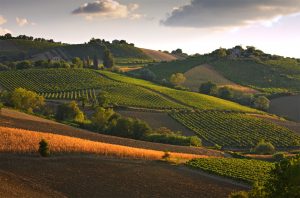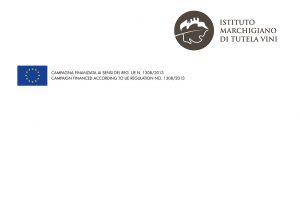Rising from the Adriatic coast to the eastern slopes of the Apennine mountains, Marche is a place where different elements meet, to shape a diverse and complex landscape.
The sea’s turquoise waters and the snow-peaked mountains are testament to these opposing natural forces that conspire to create one of Italy’s most fascinating regions. Marche has a surprising and filigreed diversity, with different terroirs, mesoclimates and indigenous grapes, translated into a rich winemaking tradition. Unlike its western neighbours, the region is home to multiple varieties and wine styles, which have evolved through centuries of trade and exchange with the many cultures that crossed the Mediterranean.
At the heart of Italy, the region occupies a strategic and symbolic place in the country’s history and soul – not merely reflected in its wine and gastronomic heritage but also, and fundamentally, in the lives and spirits of the people of Marche.
Sinuous roads serpentine through the hills, dotted with old mediaeval castles, Renaissance villas and picturesque villages. Combed by the precise lines of vinerows and plowed fields, the hills rise gently to the Apennines, where it is possible to ski while overlooking the Adriatic coast. Adventurous hikers are rewarded with fantastic vistas and stops at historical landmarks, while beach lovers enjoy the sea’s soft touch and the whisper of the eastern winds. All this is Marche, with its relaxed sophistication and unpretentious beauty.
A noble ambassador
The Istituto Marchigiano di Tutela Vini (IMT) is a leading ‘conzorzio of conzorzios’ – an umbrella institution that gathers representatives of 16 of Marche’s appelations (12 DOCs and 4 DOCGs). With a total of 556 member companies, the IMT is a unique organisation of its kind, in which the region’s multiple terroirs come together to promote not just the wine but also the culture, traditions, gastronomic heritage and landscape of Marche. The IMT represents 7,500 hectares of vineyards (45% of the regional total) across the provinces Ancona, Macerata, Pesaro-Urbina and Fermo, that produce 89% of Marche’s bottled wine.
Two of the IMT’s flagship appellations are Verdicchio dei Castelli di Jesi DOC and Castelli di Jesi Verdicchio Riserva DOCG, which have long served as ambassadors of the values, terroirs and traditions that define the Marche and, more specifically, the work developed by the IMT.

Hedonistic vocation
The land of Castelli di Jesi is a dramatic natural amphitheatre open to the Adriatic and kissed by its gentle, cleansing breezes. It rises from the sea level to the pre-Apennine elevations of Cupramontana and Apiro, at 550 metres. The etymology of Cupramontana is itself a reflection of the value of these lands: Cupra was a fertility goddess of pre-Roman settlers; ‘montana’ is an obvious reference to the mountainous landscape, important both from a natural and defensive point of view. The zone is formed by 25 villages, with Jesi as its epicentre, with 24 fortifications (borghi) that tower over the area as testimony of the region’s economic and strategic importance since immemorial times. These borghi indeed define the perimeter of the historic ‘Classico’ production zone of Verdicchio dei Castelli di Jesi.
Verdicchio evolved and adapted to this particular terroir, where Mediterranean and Continental influences engage in a beautiful dance that yields wines of great character, evocative of their place of origin. Differences in aspect and altitude produce nuanced differences, harnessed by winemakers to produce a range of profiles and styles, from fresh sparkling wines to luscious passitos. The dry, mineral-driven still wines are, however, the calling card of both appellations, and those who best express the character of Verdicchio and its affinity with the terroir of Castelli di Jesi.
Richer soils and more constant temperatures, moderated by sea winds, are key to the zesty depth of the coastal expressions. These fresh wines, perfect for easy, everyday drinking, show a pure expression of Verdicchio, with the subtle green hues that give the grape its name and the characteristic aromas of lime zest, mandarine and yellow orchard fruit. Further inland and at higher altitudes, on the other hand, hotter days and cooler nights prolong the ripening season, allowing the grapes to develop a wider range of aromas while retaining a vibrant acidity. These are key to the more complex iterations of Verdicchio, often aged for extended periods (and always for a minimum of 18 months for Riserva), showcasing the potential for complexity and the age-worthiness this variety can deliver.
True to their home, and to the deep hedonistic traditions of Marche, Verdicchio wines are particularly suited to the pleasures of the table – made to be enjoyed with food and friends. Their saline backbone and textural persistence are an invitation to enjoy grilled fish, a seafood platter or a very traditional brodetto marchigiano, a local seafood casserole-like specialty. But the persistent and lingering honeyed fruit notes of the best Verdicchios can also accompany white meats, creamy pastas, game or roasted vegetables.

Investing in the future
Aware of the singular value of its multifaceted landscape and of the biodiversity it harbours, the IMT have long committed to viticulture and winemaking practices that respect the environment and save resources. In 2020 alone, the surface area of organic vineyards grew by 6%, to a total of 6,323 hectares, thus making up 5% of the Italian total. Marche has a particularly high percentage of organic certified vineyards (35.6%), double than the Italian average. While producing 7.2% of the country’s organic wine, Marche has affirmed itself as a sustainability hub at the core of Italy. This determined approach to the future has been reflected in a deed to create a single organic district, signed with the aim of defining the largest European area dedicated to sustainable practices.
IMT’s producers know that their responsibility is, ultimately, to interpret and preserve a unique natural, cultural and historical heritage. A landscape of contrasts, that bridges the past and the future, the mountain and the sea, the soft summer breezes and the harsh mountain gusts. All these conspire to produce wines with character that are an invitation to enjoy and discover the many faces of Marche in each glass.








